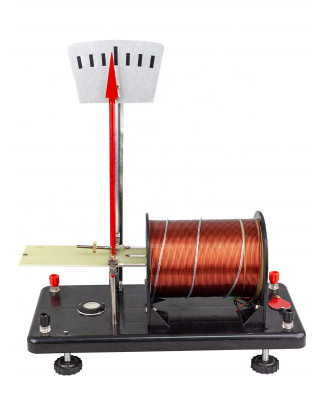Product Overview
Also known as the Magnetic Field Balance. This apparatus is used to demonstrate the force on a conductor carrying a current in a magnetic field and to investigate the factors which determine the magnitude of this force. It also can be used to calculate the strength of the magnetic field at the center of a solenoid.
The apparatus consists of a plastic base on which an air-core solenoid and two contact pillars are mounted. Each pillar is provided with an external circuit. A balanced blade is supported by the pillars on two bearings which form the fulcrum. The blade is a plastic strip with a U-shaped copper loop for currents of up to 3 amperes, which fits into the solenoid core. The base of the U will cross the axis of the solenoid at its midpoint when the blade is properly positioned on the contact pillars. Two screwed masses are provided in the blade system, one moving vertically for the adjustment of sensitivity and the other moving horizontally for the adjustment of the equilibrium position, when no current is flowing.
When current is supplied to the balance and solenoid from an external power supply, the opposing magnetic fields unbalance the blade, and it deflects. Small weights shaped like the digits 2, 4, and 6—twenty, forty, and sixty milligrams, respectively—are added to the exposed end of the blade to restore the balance. Knowing the wire weight, the dimensions of the blade conductor, and the current through it, the field strength at the center of the solenoid may be calculated. This may be repeated for various solenoid currents to show that the field is proportional to the current through solenoid. The experimental values can also be compared with values measured by a Magnetic Field Sensor or Gauss meter. With instructions.








